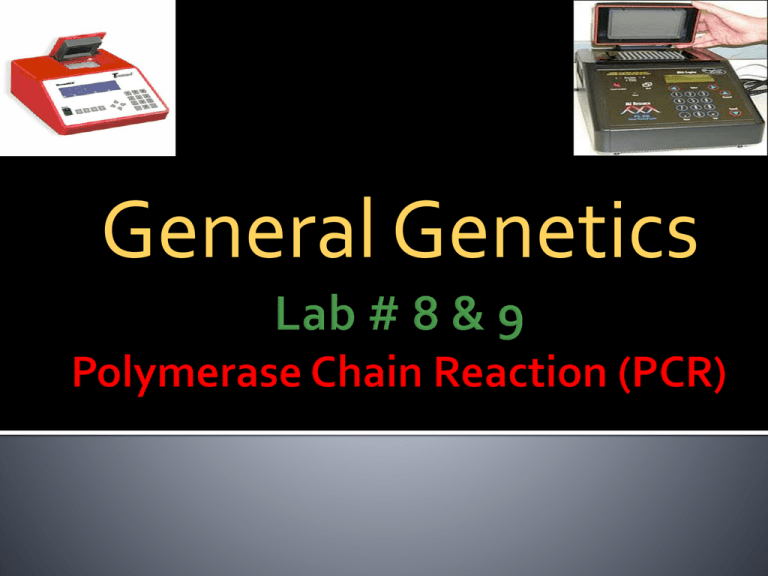Lab # 6 & 7 Polymerase Chain Reaction (PCR)
advertisement

General Genetics 1.Introduce the students to the preparation of the PCR reaction. 2.Examine the PCR products on agarose gel electrophoresis. 3.Explain some of PCR applications. Kary mullis received a Nobel Prize in chemistry in 1993, for his invention of the polymerase chain reaction (PCR). The process, which Kary Mullis conceptualized in 1983, is hailed as one of the monumental scientific techniques of the twentieth century. PCR is used to amplify specific regions of a DNA strand (the DNA target) in vitro. This can be a single gene, a part of a gene, or a non-coding sequence. Most PCR methods typically amplify DNA fragments of up to 10 kilo base pairs (kb), although some techniques allow for amplification of fragments up to 40 kb in size. 1. 2. 3. 4. 5. The solution must include: The template DNA A thermostable DNA polymerase Two oligonucleotide primers Deoxynucleotide triphosphates (dNTPs) Reaction buffer (Tris, ammonium ions (and/or potassium ions), magnesium ions, bovine serum albumin). This components must be mixed together in a solution with a total volume of between 25 and 100 microliters. Once assembled, the reaction is placed in a thermal cycler, an instrument that subjects the reaction to a series of different temperatures for set amounts of time. This series of temperature and time adjustments is referred to as one cycle of amplification. Each PCR cycle theoretically doubles the amount of targeted sequence (amplicon) in the reaction. At 30 cycles there are 1,073,741,764 target copies (~1×109). Each cycle of PCR includes steps for DNA template : 1. Denaturation : 94°C 15 sec_2 min 2. Primer annealing: 40–60°C 15 sec_60 sec 3. Primer extension: 70–74°C 1–2 minutes Denatures the target DNA by heating it to 94°C for 15 seconds to 2 minutes. The two intertwined strands of DNA separate from one another, producing the necessary single-stranded DNA template for replication by the thermostable DNA polymerase. Heating The temperature is reduced to approximately 40–60°C. At this temperature, the oligonucleotide primers can form stable associations (anneal) with the denatured target DNA and serve as primers for the DNA polymerase. This step lasts approximately 15–60 seconds. The synthesis of new DNA begins as the reaction temperature is raised to the optimum for the DNA polymerase. For most thermostable DNA polymerases, this temperature is in the range of 70–74°C. The extension step lasts approximately 1–2 minutes. The next cycle begins with a return to 94°C for denaturation. After 30–40 cycles, the amplified product may then be analyzed for size, quantity, sequence, etc., or used in further experimental procedures. Is a species of bacterium that can tolerate high temperatures one of several thermophilic bacteria. It is the source of the heat-resistant enzyme Taq DNA Polymerase, one of the most important enzymes in molecular biology because of its use in the PCR (DNA amplification technique). Taq produces an enzyme called DNA polymerase, that amplifies the DNA from the primers by the polymerase chain reaction, in the presence of Mg.





